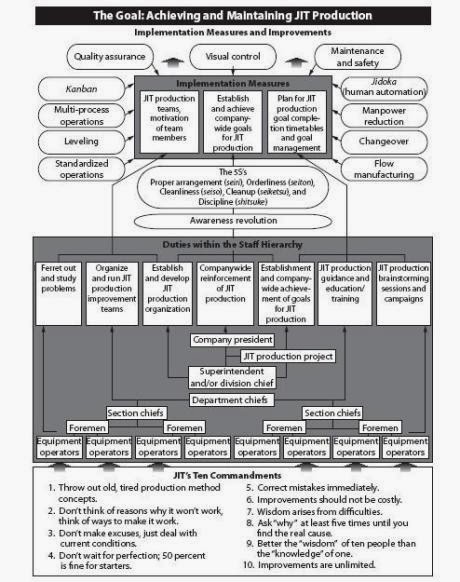If you don’t want lose your time; after you
set the gap between Current and Future VSM , you should look to create the Lean
Flow first.
Don’t make the typical mistakes to go for a
5’s campaign ; if you set your efforts to crate flow many benefits will be
carried to your organization.
(don’t worry about what many people say ;
at the end “5’s “ is part of the
process)
Benefits of Creating Flow
•
Built-In Quality;
•
Creates Real Flexibility;
•
Creates Higher Productivity;
•
Frees up Floor Space;
•
Improves Safety;
•
Improves Morale; and
•
Reduces Inventory
Fig.
The benefits of create flow are also part of
the benefits to set a 5’s campaign but goes beyond avoiding situations and
behaviors like this …
Fig.
Designing a Flow Manufacturing Process
Step 1 - Create a Value Stream Map
Step 2 - Develop Sequence of Operations
(Work Content)
Step 3 - Takt Time Calculation
Step 4 - Balancing the Flow of Work
Step 5 - Establishing Supermarket
Requirements
Step 6 - Establishing Resource Requirements
Step 1 - Create a Value Stream Map
Understand the product flow / manufacturing
sequences
- This step is
accomplished by developing a Value Stream Map
- Look at the
products as PROCESSES
- Output of
one process is consumed by the next process
- Start from
the point closest to the customer and work backward
- Start from
final assembly and move backward into sub-assemblies and to the start of
the process
Current and Future.
Fig.
Step 2 - Develop Sequence of Operations
(Work Content)
Fig.
Step 3 - Takt Time Calculation
Fig.
TAKT/Cycle/Lead Time Comparison
TAKT Time: How often we need to produce to meet customer demand without
overproducing
Operation Cycle Time: Total Time for one operator/resource to
complete their operation
Lead Time: Total Time to produce one product from the first operation to the
last operation including delays. Delays
may be due to unbalanced lines, high WIP, batching processes, between
operations.
Fig.
Step 4 - Balancing the Flow of Work
Four Steps For Balancing Operations
Based on Takt Time
1. Break Operations into Job elements
2. Identify and Remove Waste from operations
3. Define Improved job elements
4. Re-balance job elements by combining tasks
Figs
Step 5 - Establishing Supermarket
Requirements
Supermarkets are strategically placed inventory with standard
pre-determined quantities in order to:
Minimize inventory investment
Maximize protection against disruption in flow due to:
- Fluctuation
- Demand
- Quality
level
- Process
times
- Physical
location of supplying process
- Lengthy set
up time
Figs.
Step 6 - Establishing Resource Requirements
Fig.



























